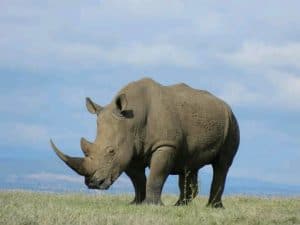Rhinos are the second largest land mammals in the world, surpassed only by the elephant in its bulk and weight. There are two species of African Rhinos and they are distinct in their own way, the White and the Black Rhino. Their names have nothing to do with the color of their skin. They’re both gray. The rhinos are among the African Big Five. Rhinos are herbivores, feeding on vegetation including fruits, twigs, stems, grasses and leaves. They have a gestation period of 15-17 months. Rhinoceros lack teeth at the front of their mouths and therefore rely on their lips to pluck food. They have few predators in the wild given their size except for humans who kill them for their horns.
Human pride, superstition and greed have unfortunately led to a great decline in these animals numbers over the past century. The illegal trade with powder made of their horns, which in some countries in Asia still is considered as medicine or just a symbol of wealth, almost causes the extinction of the African rhinos. Their horn is made of Keratin, the same stuff as our nails and hair. The horns grow from the age of one-two months and continue to grow into a distinctive horn shape throughout a rhino’s lifetime. Horns are used by rhinos as weapons during confrontations and for protection. Habitat loss is also a major threat to rhinos.
RHINO CONSERVATION
Kenya’s is committed to the conservation of rhinos and elephants. Zero tolerance to ivory trade has been demonstrated by burning them at the ivory burning site in Nairobi National Park. The good work of rangers who protect the animals in Kenya’s national parks, the community and private land conservancies have also led to reduction in the number of rhino and elephants poached. Increased levels of security have been complemented by tougher sentencing guidelines for wildlife crime and by community engagement initiatives. Ol Pejeta Conservancy in Kenya is one of the largest rhinoceros sanctuaries in the world and home to Najin and Fatu, a mother and daughter who are the last living northern white rhinos in existence.
There are many distinctive features and characteristics that distinguish the two species. Some of these include appearance, diet, habitat, and behavior. Below are the differences between the two:
Black Rhino

White Rhino

There is actually no color difference between the white and black rhino. They are both of a dark grey color. The last two northern white rhinos on Earth live in Ol pejeta Conservancy in Kenya. Najin and Fatu are the only two rhinos of their species in existence.
